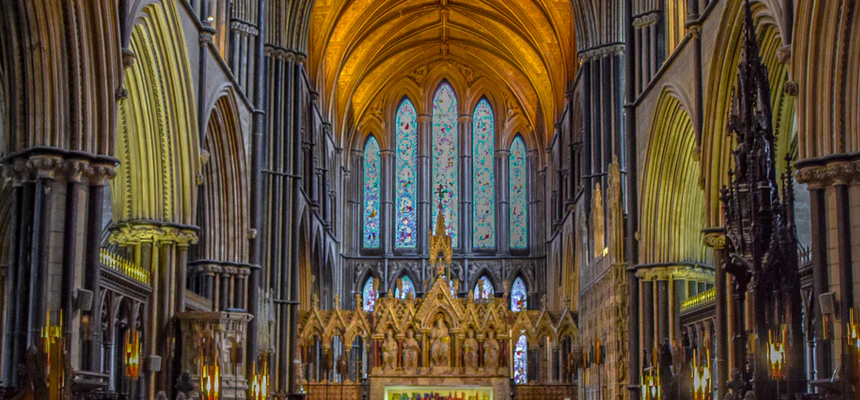
Dauferio of Benevento, Pope Victor III, was born around 1026, possibly the son of Prince Landulf V, a Lombard prince. As an only son, the family expected Dauferio to marry and carry on the family name. However, twice he managed to escape arranged marriages and go to a monastery. The second time he fled to Cava, getting permission to enter the monastery of S. Sophia. This was an abbey established by the Benevento family a generation before. Dauferio took the name Desiderius. The monastery was not strict enough for him, so he went to the island monastery of Tremite on the Adriatic. In 1053, he joined some hermits at Majella in Abruzzi.
About this time, Desiderius was brought to the attention of Pope Leo IX. Leo was fighting the Normans who had taken over much of southern Italy. Possibly, Desiderius was hired to negotiate peace with the Normans after the battle of Civitate, as Pope Leo was held prisoner for months. Leo was freed but died a month later.
The new pope, Victor II invited Desiderius to join the papal court being held in Florence. While there, the young monk met two monks from Monte Cassino. The next year he joined them at the famous monastery. He soon joined the religious community and was appointed the superior of a dependent house at Capua.
In under two years, Pope Stephen, who was also the abbot of Monte Cassino, returned to the abbey, sick, and ordered an election for a new abbot. Desiderius won. Stephen recovered and insisted that he would hold on to the abbacy. He then appointed Desiderius as legate to Constantinople. About to go aboard a ship at Bari, the monk heard of Stephen’s death. Getting safe-conduct from the Normans, Desiderius went back to Monte Cassino and was installed as abbot at Easter, 1058.
This began the golden age of Monte Cassino. Besides St. Benedict, Desiderius was the premier abbot in Monte Cassino’s history. He rebuilt the church and conventual buildings, established schools of art and reestablished disciplines. His reputation brought many gifts and donations to the monastery. He acquired many of the gifts from the Byzantine Empire that had been stolen and pawned some years before. This abbot pushed the monastery to be a center of intellect. He ordered at least seventy books copied including those of Augustine, Ambrose, Josephus and Virgil. Desiderius was also appointed papal vicar for much of southern Italy with the power to reform monasteries.
In recognition of his work, Nicholas II consecrated Desiderius a cardinal.
Desiderius began to work with Pope Gregory VII, the strict reformist. He negotiated with the Normans and, later, Emperor Henry IV for the pope. The abbot was gentler than the pope and felt he was a middleman. The two did not always agree but worked together. However, Gregory named the abbot as one of the fittest to succeed him.
When Gregory died in exile, 25 May 1085, getting a new pope into Rome was very difficult. The emperor nominated his own “pope”, Clement. Clement received an army and marched on Rome. Many cardinals wanted Desiderius to be elected. Desiderius did not want the honor. So, he went into hiding on several occasions to avoid it. Eventually, he was elected on 24 May 1086, a year after Gregory’s death.
At the same time, the Normans, who had signed fealty to the pope, were attacking Sicily. They got rid of most ofthe Muslims by the turn of the century.
A SHORT PAPACY
The antagonism of Anti-Pope Clement and his supporter, Emperor Henry made Rome an unsafe place. The unstable fealty of the Normans was safer. Desiderius, took the name Pope Victor III and left for Monte Cassino, before being consecrated. He went back and forth several times before being consecrated and enthroned on 9 May 1087, a year after the election. At his First Mass, it was obvious that Pope Victor was very sick. He could not complete the Mass or any other Mass during his papacy, it was said.
The summer of 1087 was very busy for Victor. He called a council at Benevento. Here, he renewed the excommunication of Clement, and condemned lay investiture, putting another nail in the coffin of this illicit act. At the same time, Victor sent an army of Italian troops to Africa where they captured the town of El Mahadia. His representatives forced the Muslim ruler of Tunis to free Christian slaves and pay tribute to the Holy See.
At the council, Victor got sicker. He returned to Monte Cassino, knowing he was not going to last long. He suggested Odo of Ostia as a successor to the throne of Peter. Then, he died 16 September. Victor is one of the few popes not buried in Rome. He was buried at the church at Monte Cassino.
Pope Victor III was beatified by Pope Leo XIII in 1887.

Recent Comments